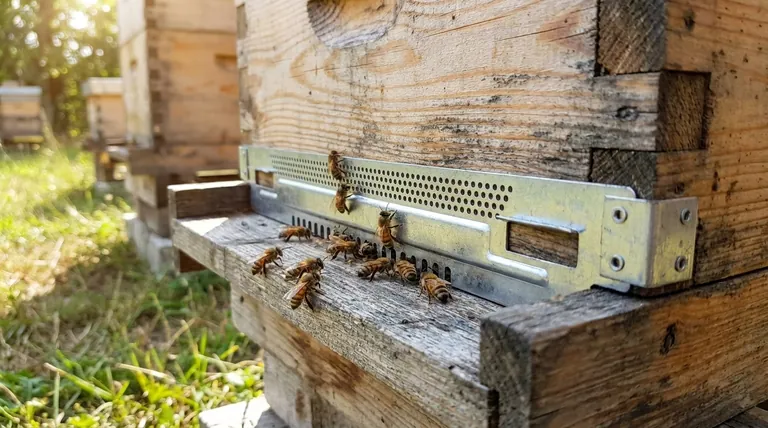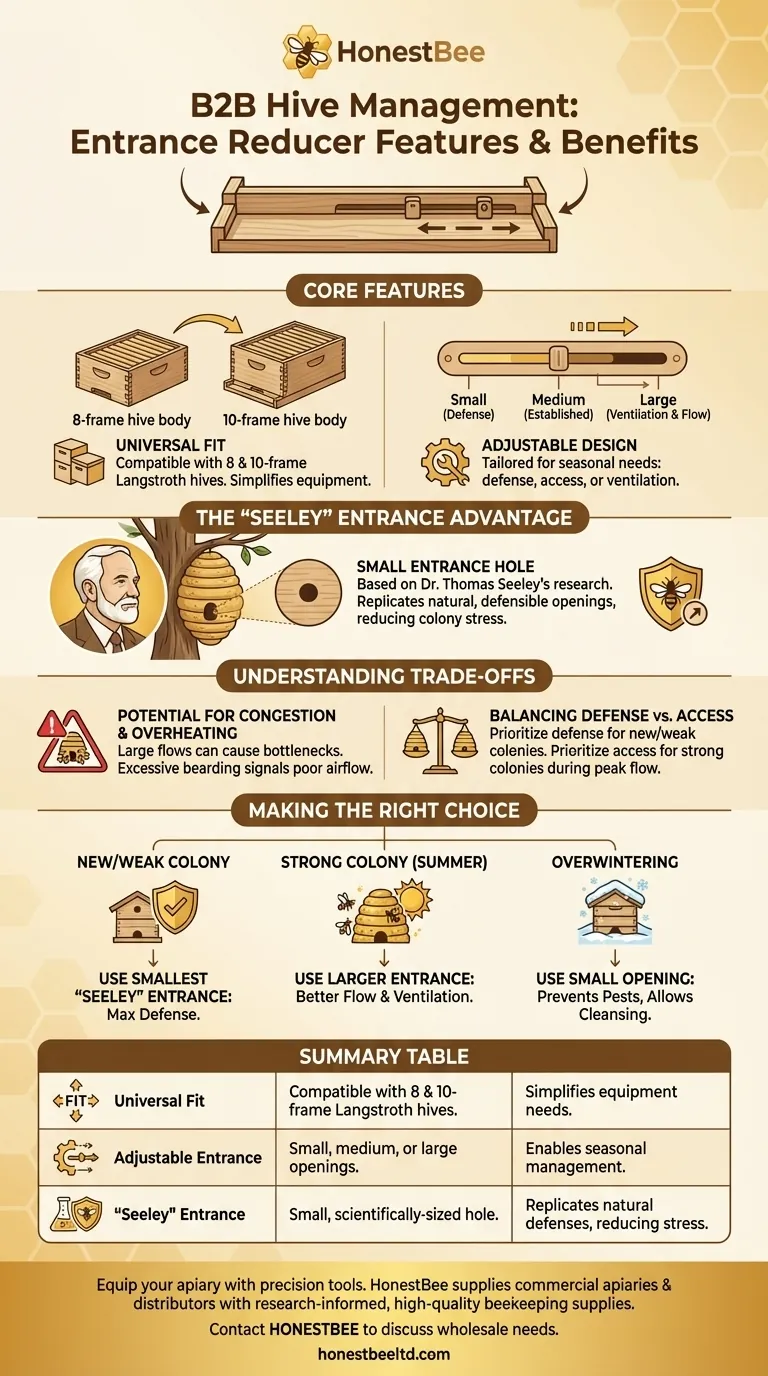At its core, the entrance reducer designed for 8 and 10-frame equipment incorporates two primary features. It is built to be adjustable for different management needs and includes entrance holes sized according to the scientific research of Dr. Thomas Seeley, which replicate the entrance dimensions bees naturally prefer in the wild.
This reducer is more than just a block of wood; it's a management tool designed to align with a honey bee colony's natural defensive instincts. By understanding its features, you can better support your hive's security and health throughout the year.

The Core Design Principles
To use this tool effectively, you must understand the purpose behind each design choice. The features are not arbitrary but are based on both practical beekeeping needs and biological research.
Universal Fit for Standard Hives
The reducer is designed to work seamlessly with both 8-frame and 10-frame Langstroth equipment. This versatility means a single tool can serve the most common hive body sizes used by beekeepers, simplifying your equipment needs.
Adjustable for Seasonal Management
The ability to adjust the entrance size is critical for hive management. A large opening is beneficial during a strong summer nectar flow, but it becomes a liability at other times.
This reducer allows you to provide a small, defensible opening for a new or weak colony, a mid-sized opening for an established colony, or a wider opening for maximum ventilation and traffic flow.
The Science Behind the "Seeley" Entrance
The most significant feature is the inclusion of holes sized according to the work of Dr. Thomas Seeley, a leading honey bee biologist.
His research on feral honey bee colonies living in natural tree cavities revealed that bees consistently choose nests with very small entrances. An opening of this specific size is far easier for guard bees to defend against robbing bees, wasps, and other intruders, which reduces overall colony stress.
Understanding the Trade-offs
While a small, defensible entrance is often beneficial, it is not a "set it and forget it" solution. Proper entrance management requires observing your colony and the environment.
Potential for Congestion and Overheating
A small entrance can become a bottleneck during a heavy nectar flow. This can slow down foragers and reduce the hive's efficiency.
In hot weather, a restricted entrance can also hinder ventilation, potentially leading to overheating. Watch for excessive "bearding," where a large number of bees cluster on the outside of the hive, as a sign of poor airflow.
When to Prioritize Defense
The smallest "Seeley" style opening is most critical when the colony is vulnerable. This includes newly installed packages or nucs, weak hives, and periods of intense robbing pressure from other colonies, typically in late summer and fall.
When to Prioritize Access
For a strong, populous colony during the main nectar flow in late spring and summer, a larger entrance is often necessary. This maximizes foraging efficiency and helps the colony regulate its internal temperature.
Making the Right Choice for Your Hive
Your goal should be to match the entrance size to the colony's current strength and the environmental conditions.
- If your primary focus is protecting a new or weak colony: Use the smallest "Seeley" entrance to give your bees a significant defensive advantage.
- If your primary focus is maximizing a strong colony's summer honey production: Use a larger opening for better traffic flow and ventilation, but be prepared to reduce it if you see signs of robbing.
- If your primary focus is overwintering: Use a small opening that prevents mice from entering but is large enough for bees to exit on cleansing flights.
By actively managing the hive entrance, you empower your bees to do what they do best: defend their home and thrive.
Summary Table:
| Feature | Description | Key Benefit |
|---|---|---|
| Universal Fit | Compatible with both 8-frame and 10-frame Langstroth hives. | Simplifies equipment needs for standard hive bodies. |
| Adjustable Entrance | Allows for small, medium, or large openings. | Enables seasonal management for defense or ventilation. |
| "Seeley" Entrance | Includes a small, scientifically-sized hole based on Dr. Thomas Seeley's research. | Replicates natural defenses, reducing colony stress from robbing and pests. |
Equip your apiary with precision tools designed for success. The right entrance reducer is a cornerstone of effective hive management. At HONESTBEE, we supply commercial apiaries and beekeeping equipment distributors with high-quality, research-informed beekeeping supplies through our wholesale-focused operations. Let us help you strengthen your hive's defenses and support colony health year-round.
Contact HONESTBEE today to discuss your wholesale needs and discover our full range of durable, effective beekeeping equipment.
Visual Guide

Related Products
- Beehive Entrance Reducer Guardian Metal Hive Entrance for Bees
- Multi-Functional Sliding Hive Entrance for Beekeeping
- Multi-Functional Rotary Hive Entrance Disc for Beekeeping
- Professional Reversible Beehive Hive Entrance
- Professional Galvanized Hive Strap with Secure Locking Buckle for Beekeeping
People Also Ask
- How can a Langstroth hive entrance be adjusted? Mimic Natural Bee Preferences for a Healthier Hive
- What are the features of the side with oblong holes in the entrance reducer? A Guide to Hive Defense & Health
- What should be done after transferring frames to the new hive? Essential Steps for a Secure Colony
- What are the different entrance sizes for an 8 or 10-frame Langstroth hive? A Guide to Seasonal Management
- What size is the entrance hole in a native bee hive? The 13mm Standard for a Thriving Colony



















